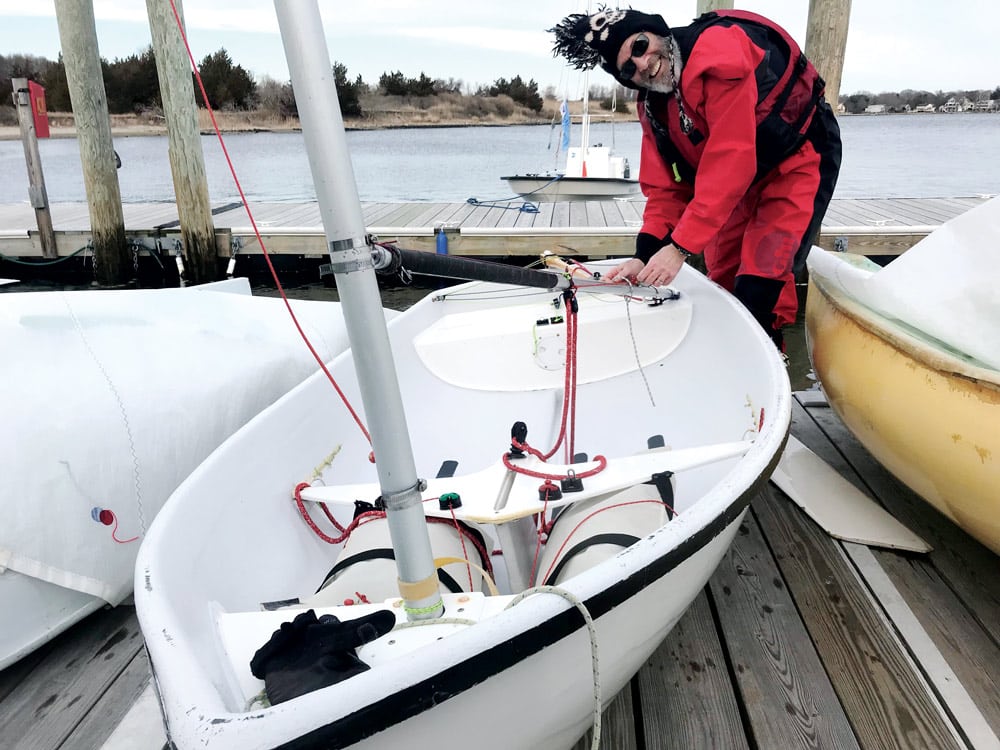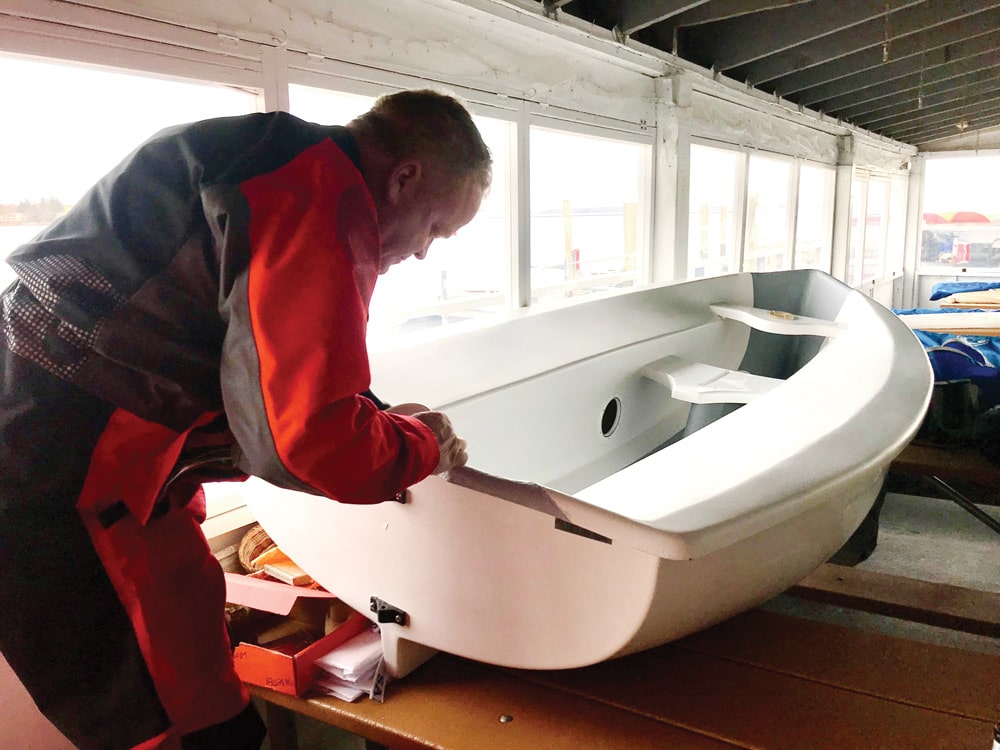
Frostbite racing in the Northeast has been going on for ages, especially in Wickford Harbor, Rhode Island, where the Sea Dogs have romped every Sunday since the 1960s. Chuck Allen, Wickford YC’s past commodore, had been raving to me about them, so I recently texted him on a whim and asked if there was spare boat I could race with them for a day. “Yes,” he replied. “First race is at 1, but people start showing up at noon.”
Anxious to rig, source a few pointers, and get a handle on the boat before the first race, I pull into Wickford YC’s clamshell parking lot early on a Sunday morning in January. The club is deserted, so I mosey down to the docks to inspect rows of overturned dinghies. I assume them to be Sea Dogs, and upside down, they look simple enough.
Promptly at noon, the first sailor arrives, jumps out of his BMW, and heads straight to his craft. It’s Wickford YC Commodore Gordon Fletcher, a relative newcomer to the Sea Dog fleet. I introduce myself and help him flip his boat, which is when I begin to learn no Sea Dogs are alike. Fletcher explains how his is heavily modified, with watertight tanks and cut-out transom, then points out a few shiny new Sea Dogs farther down the dock.
Allen eventually pulls into the lot and hops out of his silver Ford Ranger. It’s 30 degrees and he’s in a thin, long-sleeve shirt, sweatpants, socks and sandals: the attire of a frostbite nut job. He’s a sailmaker with North Sails, a Sea Dog “world champion,” and the energy fueling Wickford’s Sea Dog resurgence. He introduces me to a few others, including young newcomer Ross Ween.
“He came once,” Allen says as he turns over his own boat, “and now he’s totally into it.”

Allen’s Sea Dog is nothing like the sparkling new fleet-owned boat sitting inside the club awaiting its hardware. Ugly would be a compliment, but his Dog is stiff — and fast. Whether it would pass class measurement is debatable, but it doesn’t matter because there are no hard-and-fast rules anyway. His also has tanks, which he explains is a “game changer” in Sea Dog sailing.
“They make the boat a lot safer and easier to sail,” Allen says. “With the old way, you’re either sitting on the hard rail or inside the boat on your knees.”
Alongside his boat are a few relics. Judging by their appearance, some of them might have been around when the Sea Dog was first commissioned by frostbite sailors at Sachem’s Head YC, in Guilford, Connecticut. Early Dogs were built by Skimmar in Greenwich, Conn., (for $425) which claimed the pudgy 9-foot, 125-pounder could be sailed safely in winds up to 25 knots, and would outperform any similar-size dinghy. They also claimed it to be unusually seaworthy — a claim that’s easy to refute.
“If you capsize one of the older boats,” I’m told, “Don’t fight it. Just go swimming, let it sink, and wait for the race committee to come pull it out.” Later in the day, I will witness this phenomenon. Ween, in a borrowed old boat, submarines on a downwind leg, filling the boat to its gunwales. The race committee retrieves his bowline, which is then tied to a sprit extended off the top of a mast on the race committee boat. They pull the bow skyward and the boat dangles in the air as seawater pours out. When it’s empty, Ween is back in action and the racing resumes.
This delay is a chilling showstopper, which is why new and many retrofitted Sea Dogs have watertight tanks, introduced a few years ago. The new boats, which also have beautiful glass blades, Dwyer spars and quality hardware, go for about $3,500, and the builder (Jibe Tech), I’m told, has been stamping them out. Growth in Wickford and Sachem’s Harbor, Allen says, is a testament to their efforts to update the boat for the better. Plus, more sailors are showing up each week and the racing is more competitive than before.
Not everyone’s completely onboard with the new breed, however. Skip Whyte is a past Sea Dog world champion, and his father was a fleet founder, but he’s turned off by the rampant modifications of the past few years. It’s a story heard often with reborn one-design fleets: a few good sailors start messing with old boats with good intentions, but the old dogs soon become obsolete.
“The new boats are easier to sail and self-rescuing, which is all good,” Whyte says. “But they’ll never be faster than the custom boats.”
He may be the grumpy minority, but he has a point: New boats will grow the fleet, but custom Sea Dogs will continue to win. Greg Phipps, who led the evolution, says the custom boats are consistent with the spirit of class rules: to keep racing fair, safe and fun, and promote growth. “Ironically, the old dogs are the ones that were saved from the scrap heap and are winning for now,” he says, “but that will change when the fleet’s better sailors start sailing the new boats.”









